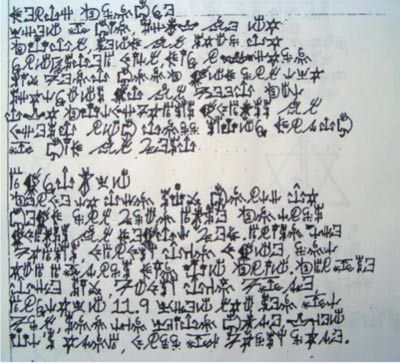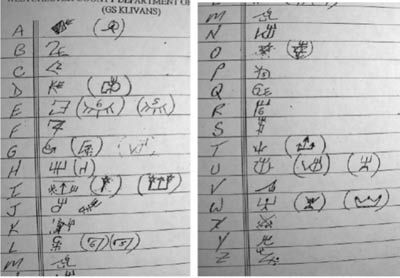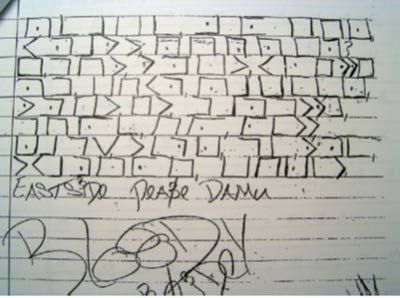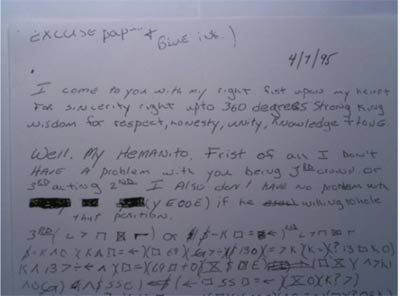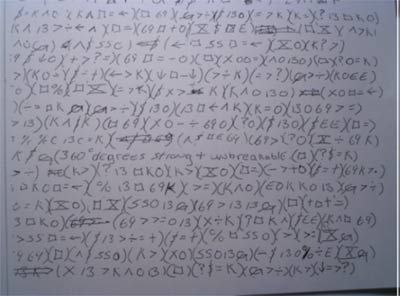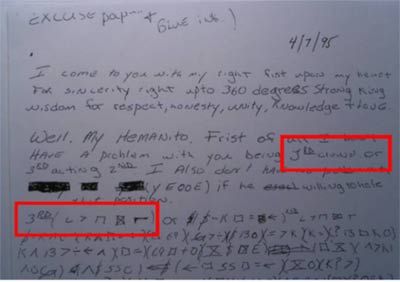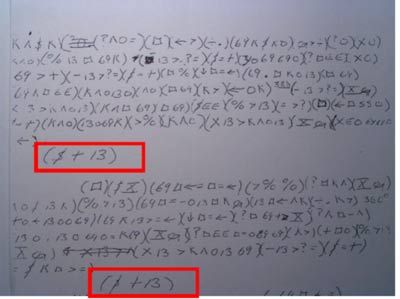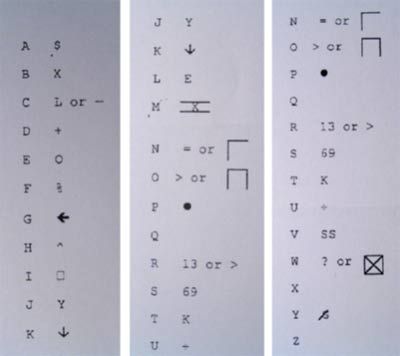By Gary Klivans
Can you keep a secret? Gangs’ use of codes is one of the most fascinating and least understood aspects of gang investigation. If anything speaks to the fact that these groups are well-established and sophisticated, it is the way that they communicate using gang codes. Gangs are cultures within our Culture and societies within our Society. For example many larger, well established gangs have their own societal rules of behavior (laws), tribunals to punish rule-breakers (courts), dues collection (taxes) and even their own holidays! The way in which we try to decipher gang codes is also sometimes misunderstood.
Technicians in white lab coats monitoring blinking lights on large banks of computers, or a large room divided into cubicles filled with assistants diligently counting symbols or words to be analyzed using letter frequency or word frequency charts. That’s how most people envision the “science” of deciphering a code.
In some cases, a version of this vision may be right, but analyzing a gang code presents definite problems for science. Gang codes will sometimes use more than one symbol to represent a letter of the alphabet. This hampers the use of letter frequency charts. Gang codes use gang or prison slang. A phrase like “Send me a kite” might not make sense to the code “scientist”, and make translation difficult. Perhaps most troubling to the science of deciphering, is the fact that writers of documents written in a gang code don’t spell words correctly or use rules of grammar.
When the science of deciphering a gang code fails, it’s time to turn to art. The art of deciphering a gang code, much like being a brew master or great chef, uses both science and experience. A brew master or chef knows all the ingredients and the times and temperatures required to create a great beer or meal, but along the way, subjective analysis comes into play: “It needs another five degrees of heat” or “Add a little salt”. So too, the art of deciphering a gang code requires that the analyst knows what is important to the culture of the gang member who is writing the questioned document. History, identifiers and how a gang communicates are all components of the subjective analysis required to decipher the coded document.
In the following code samples, I will explain how I used the “art of deciphering” and the “science of code breaking” together to decipher a coded document.
The samples shown in (Illustration #1 & #2) are examples of a Black Gangster Disciple (BGD) code that I deciphered by developing the information shown in (Illustration #3). If the science of counting the frequency of symbols was used to try to decode this document it would fail because the writer used multiple symbols to represent some letters of the alphabet (Illustration #3).
| Illustration 1 |
|
|
| Illustration 2 |
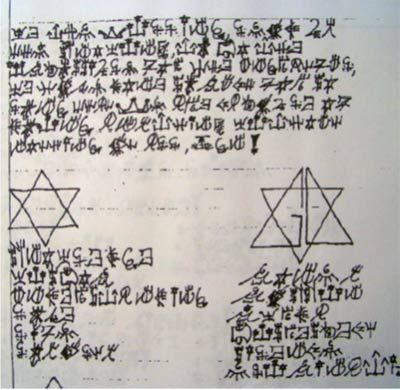 |
| Illustration 3 |
|
|
I was able to begin the translation of this document because I recognized the symbols used by the BGD and then used that information to identify words and phrases that are important to the philosophy of this gang. I have found that the method of “knowing what is important to the writer” can be a valuable tool in deciphering gang codes. The document in this sample is a document produced by the Black Gangster Disciples. This gang uses very ornate and complex symbols.
The Black Gangster Disciples are associated with the Folk Nation gangs and use a lot of identifiers associated with their Gang and Nation such as a “pitchfork”, the number “6”, the number “5” placed upside down (to indicate disrespect for the rival People Nation), the six-sided “Star of David” symbol (to honor one of the Black Gangster Disciple founders, David BARKSDALE), and numbers “74” (for “GD”).
The sample pages shown (Illustration #1 through #7) is part of a fifteen page sample confiscated by law enforcement. Specifically, I was able to determine the words identified in (Illustrations #4 through #7) because I knew that these phrases were important to the members of the BGD.
| Illustration 4 |
 |
The first line of this paragraph was “All Is Not Well”
| Illustration 5 |
 |
The second line contained “All’s Well” (Note the punctuation).
| Illustration 6 |
 |
The fourth line contained “All Is Not Well,”
| Illustration 7 |
 |
The fifth line contained “All Is One,”
Sometimes a gang member wants to hide his affiliation to a specific gang and does not use recognizable identifiers to connect them to the gang. I was told by the agency that confiscated the following code sample that the document shown in (Illustration #8) was written by a member of the Bloods gang, but the document does not use commonly recognized Bloods gang identifiers like: “B’s ” or “C’s ”. None of the letter “¢’s” were crossed out, no familiar three dots in a “dog paw” pattern.
| Illustration 8 |
 |
As I examined the document I saw what appeared to be the word “Bloods” as shown in (Illustration #9). Using this as a guide I placed some of these now “known” letters back into words in the document and mixed with a little more art and science, I was able to decipher the remaining portions of the coded document and develop the list of code symbols shown in (Illustration #10).
| Illustration 9 |
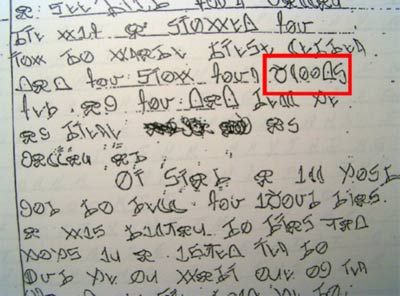 |
| Illustration 10 |
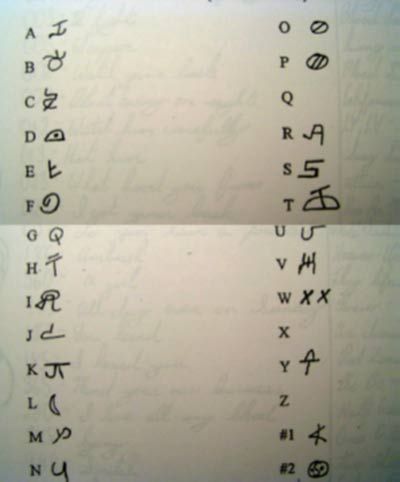 |
On occasion, a gang will use a recognized type of code. For example, (Illustration #11 & #12) shows the use of a “Tic Tac Toe” type code, in this case used by the Bloods gang. This code uses geometric designs, usually a square, and an “X” in combination with a “dot” to create symbols to represent letters of the alphabet. The figures shown in (Illustration #11) depict a basic form of this type of code which was initially created by Rosicrucian’s and Freemason’s.
This type of code can be identified by the type of symbols which are taken from shapes made from components of a “tic-tac-toe” symbol, also called a “pound sign” or Octothorpe and an “X” symbol. The standard configuration for this type of code uses two “tic-tac-toe” symbols (one with ‘dots’ and one without) and two letter “X’s” (one with ‘dots’ and one without). Letters of the alphabet are placed in the open portions of these symbols and then the letters are assigned that shape. This type of code is very flexible because the users can place any letter in any symbol opening.
| Illustration 11 |
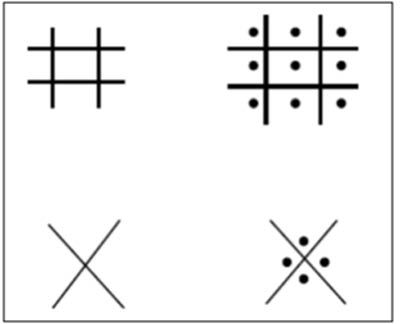 |
You can see in (Illustration #12) how the symbols used in the document are formed by the shapes, which are assigned letters of the alphabet. Note the use of ‘dots’ to indicate which “tic-tac-toe” or “X” symbol is to be used.
| Illustration 12 |
|
|
The art of deciphering again provided a starting point. Through familiarity with the way that Bloods communicate with each other, I was able to recognize that the first line said “Peace, Blood” and from this “artful” beginning, was able to use “science” to create the symbol table shown in (Illustration #13) which identifies the geometric shape which represents a letter of the alphabet.
| Illustration 13 |
|
|
As I said at the beginning of this article, it’s important to know about the history, identifiers and what’s important to the gang member creating the code.
Some gangs, like the members of the Almighty Latin King Queen Nation (ALKQN), AKA the “Latin Kings”, are so rich in history, identifiers and lifestyle that the code shown below is easily identifiable as being a Latin King document and some of the clues to deciphering this code come from the art of knowing their philosophy. This document (Illustration #14 and #15) starts in English and then becomes code symbols. The author of this document was unusually kind, in that individual words are contained in parenthesis within the document.
| Illustration 14 |
|
|
| Illustration 15 |
|
|
Some of the art of deciphering this document was in knowing how important the “Crown” and the phrase “Amor de Rey” are to the Latin King gang (Illustrations #16 & #17). Note that in (Illustration #17) the term “Amor de Rey” is abbreviated as “ADR”. This phrase is so central to the Latin Kings that I knew that the three-letter symbols had to be “ADR”. There are numerous spelling errors in this document (e.g. in illustration #14 and #16, the word “first” is spelled “frist”) which would have hampered the use of science without art. The code symbols used in this document are shown in (Illustration #18).
| Illustration 16 |
|
|
| Illustration 17 |
|
|
| Illustration 18 |
|
|
We’ve looked at several different types of codes. One code we deciphered because gang symbols were used to properly identify the gang and then by knowing and finding phrases that are important to that gang culture. Another gang code deliberately avoided familiar symbols but was able to be deciphered because of the use of the gang name within the document. Another sample was a well-known type of code that has been adopted by gangs. This code was broken because of familiarity with the way gang members communicate with each other. Finally, we examined a code used by a gang that is rich in “culture” and “history” and this code was deciphered as a result of knowing what was important to the code writer. All of these codes were able to be deciphered by using a combination of science and “the art of deciphering a gang code”.
___________________
About the author: GS KLIVANS is a gang consultant and lecturer. He is employed as a Captain by the Westchester County (NY) DOC (Peace Officer). Captain KLIVANS is a former District Attorney Investigator (Police Officer). He served in the US Army Reserve for 30 years in Military Intelligence and CID (Federal Agent).
He can be contacted at: KLIVANS@optonline.net


